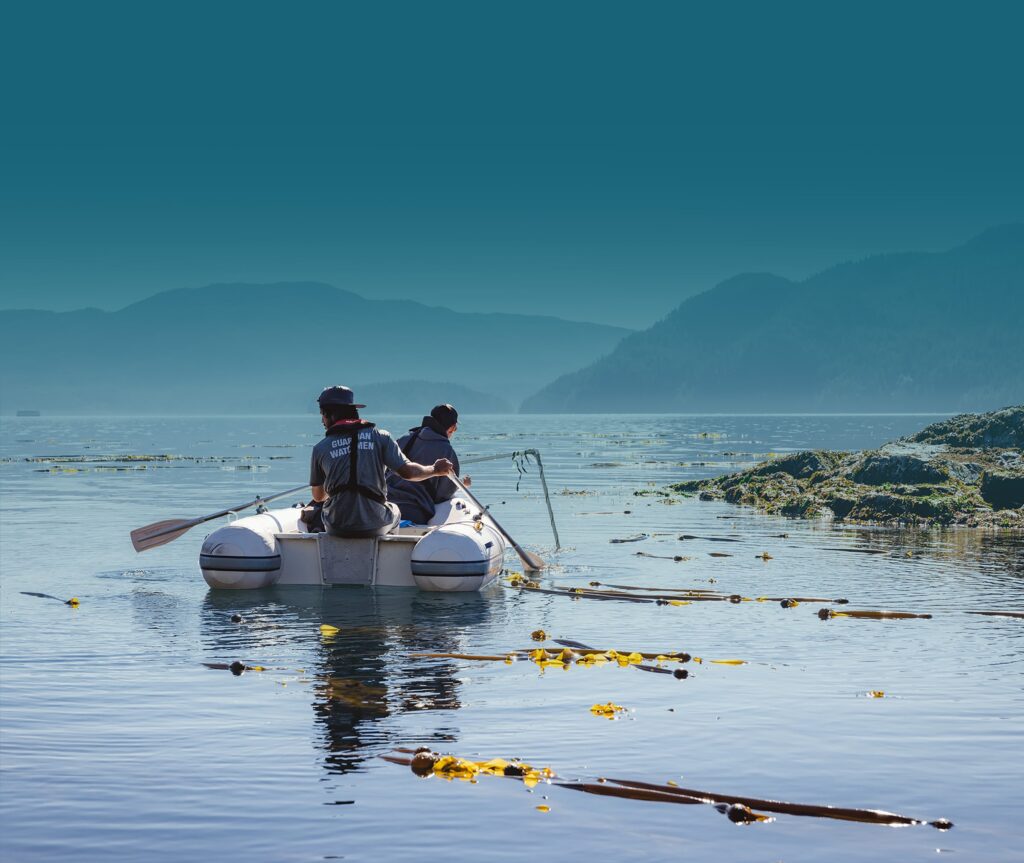A whole ecosystem
approach

10 million
hectares
of culturally and environmentally significant ocean
Made by the coast,
for the coast

17 First
Nations
in partnership with the Government of British Columbia and the Government of Canada
In one of the richest cold-water
environments in the world

84 species
at risk
to be protected and conserved using traditional knowledge and science

We’ve always been involved with taking care of our resources. It would be easy for us if it was only about money, but there’s cultural and natural values out there that are worth more than money.
Harvey Humchitt – Heiltsuk Hereditary Chief
We’ve had lessons learned from the Great Bear Rainforest agreement and the implementation of that, and that’s changed our lives as far as on the terrestrial side of how things are protected.
Christopher Roberts – Wei Wai Kum Elected Chief Councillor

Great Bear Sea PFP
A Model for Stewardship, Conservation and Sustainable Economic Development
Covering two-thirds of the coast of British Columbia, the Great Bear Sea (also known as the Northern Shelf Bioregion) is one of the most environmentally and culturally significant cold-water environments in the world.
An ecological and cultural treasure, the Great Bear Sea is located off the North and Central Coasts of BC, including Haida Gwaii and the waters around northern Vancouver Island.
These waters support an incredible mix of habitats – open ocean, vibrant estuaries, dense kelp forests, expansive coral and sponge beds, and deep fjords–which, in turn, have sustained our coastal communities for thousands of years.
Today, overfishing, habitat loss, increased shipping traffic, and climate change are having an impact on the Great Bear Sea and contributing to declines in fish, bird, and shellfish populations – harming our coastal peoples and the wildlife that depend on a healthy ocean, and threatening a careful balance that First Nations have maintained for millennia.
To help address these challenges, First Nations have led a groundbreaking initiative to establish the Great Bear Sea project finance for permanence (PFP) initiative, which is a model for long-term, large-scale conservation that brings partners, funding, and management plans together to support lasting protection of a region. Importantly, the vision for the Great Bear Sea PFP includes funding for stewardship and sustainable economic development.
The Great Bear Sea PFP was announced by 17 First Nations, in partnership with the Government of Canada and the Province of British Columbia on June 25, 2024, securing $335 million of durable, long-term funding to care for our marine territories and support sustainable economic development on the coast. Learn more about the closing of the Great Bear Sea PFP agreements.

Our Great Bear Sea PFP will build on the success of the Great Bear Rainforest agreements (2006) and will extend our vision for conservation and well-being from the forest into the sea, to create the world’s largest and most ecologically robust Indigenous-led, collaboratively developed ecosystem-based management initiative.
Impacts from the Great Bear Rainforest – A Case Study

18 Guardian programs established

1,292 permanent jobs generated

138 businesses acquired and created

$418.8M in investments to the coast
Anticipated Benefits of the Great Bear Sea PFP – A Win-Win Scenario

3,000 new jobs

32,000 days of skills training

Restore and grow fish stocks

Contribute to global 30 by 30 conservation goals
The Great Bear Sea PFP will benefit coastal communities and economies, while protecting our shared environment.

Marine Protected Area Network – An Action Plan
For over 10 years, First Nations have worked in partnership with the Government of British Columbia and the Government of Canada – and with the involvement of industry, community and local governments – to design a network of Marine Protected Areas (MPAs), which will designate levels of conservation and permissible industry activities in areas of importance. Leaders shared and endorsed the MPA Network Action Plan in February 2023, at the IMPAC5 marine conservation summit.
The MPA network covers 30 per cent of the Great Bear Sea, and includes new protected areas and enhancements to existing MPAs. Learn more about the MPA network and commercial fishing here.

Fish

Sea birds

Whales

Kelp

Sea grass
Our MPA network will preserve and connect habitats for important species, including more than 80 species at risk.
Learn more


